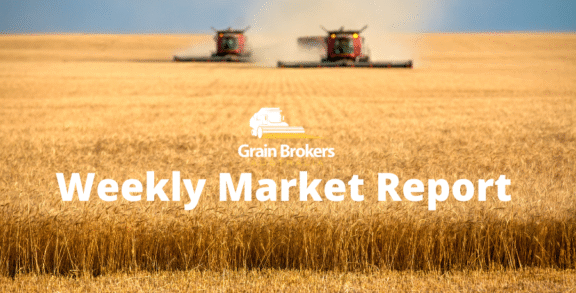The production outlook for Canada’s wheat, barley, oats and canola crops are stumbling amid persistent hot and dry weather conditions across the prairie provinces, while corn and soybean output is expected to increase year-on-year as eastern Canada has enjoyed higher-than-average rainfall since the beginning of the growing season. The decreased winter and spring crop production is primarily driven by lower yields, with oats the only major crop with a lower planted area than last season.
Statistics Canada released its latest model-based production estimates for the nation’s principal field crops last week using a yield simulation template incorporating satellite technology, its field crop reports and agroclimatic data as of July 31, just as this season’s winter and spring crop harvest commenced. This report precedes another, but different, model-based report, which will be released on September 14 using data as of August 31.
Drought conditions across the central winter and spring cropping regions are the second worst in twenty years according to Gro Intelligence’s drought index, and their vegetative health index across the major cropping regions, which began falling dramatically in early July, is close to the lowest recorded this century. In fact, Canada’s spring wheat areas have been signalling potential production issues since the start of the season, according to Gro’s yield forecast model, due to the below-average soil moisture reserves coming out of the northern hemisphere winter.
Canada’s total wheat production is forecast at 29.5 million metric tonne, 14.2 per cent lower than the 2022 output and 6.3 per cent below the five-year average. While the harvested area forecast of 10.7 million hectares is 6.3 per cent higher year-on-year, the average yield of 2.77 metric tonne per hectare is 18.6 per cent lower, leading to the sharp production decline. Only the disastrous 2021 wheat harvest of 22.4MMT has been lower in the last eight years.
The lower output is reflected in a 16.3 per cent retraction in the export estimate to 21MMT, which will leave a very meagre carry-out of just 2.5MMT, or around 30 days of demand. The Canadian export program was robust in 2023, approaching record levels, and the lack of high protein milling wheat in the export market will be felt in 2023/24.
The wheat production decrease is mainly attributable to spring wheat, with output forecast to fall by 14.5 per cent to 22.1MMT. The estimated yield is down 19.9 per cent to 2.82MT/ha off an anticipated harvested area of 7.9 million hectares, 6.9 per cent higher than last year and the largest since 2001. Durum wheat production is expected to fall by 26.4 per cent to 4.3MMT compared to 2022, with the harvested area down 1.5 per cent to 2.4 million hectares and yield down 25.3 per cent to 1.8MT/ha. This would be the second-lowest Canadian durum wheat crop in the last 12 years and falls significantly short of the 5.1MMT of export demand seen in 2022/23.
Canada generally accounts for around half of global durum trade, and the nation’s pipeline is empty after a massive export program over the last twelve months. With bad weather in Europe damaging durum crops in Spain, France and Italy, and lower production in the United States, pasta lovers worldwide will likely be paying higher prices for their favourite dish as supplies available to flour millers and food companies tighten dramatically in 2023/24.
The national canola harvest in 2023 is projected to fall by 6.1 per cent to 17.6MMT compared to last year, 5.6 per cent below the five-year average, and the second smallest crop in the past nine years. This season’s canola yield is expected to be 1.98MT/ha, 8.8 per cent lower year-on-year off a 3 per cent higher harvested area of 8.9 million hectares. Saskatchewan, which accounts for 56.1 per cent of the nation’s anticipated harvested area, was the big mover, with this season’s yield projected to be 13.9 per cent lower than last year at 1.83MT/ha.
Reduced Canadian output is bullish for both canola and global oilseed markets. Recent history suggests that domestic use across the globe is difficult to curtail. Canadian crush capacity has risen substantially in recent years, so it’s the global consumer that likely will go without. Assuming Statistics Canada’s initial production forecast pans out, Canadian exports will probably be at a three-year low of 7.2MMT. This leaves little room for yield loss in Australia this season as the crop enters its critical seed development stage with soil moisture concerns in many regions.
This season’s barley crop hasn’t escaped the drought, with the yield forecast down 21.4 per cent to 2.98MT/ha compared to 2022. Despite a 2.2 per cent increase in the estimated harvested area, production will fall by 20.7 per cent to 7.9MMT in 2023. Canada has traditionally been a fierce competitor for Australia into the lucrative Chinese market. China accounted for 91 per cent of the 2.9 million tonnes of Canadian barley exports through the first 11 months of the 2022-23 campaign before the tariffs on Australian barley were removed. Lower Canadian production will mean a smaller exportable surplus, which is only good news for Australian growers in 2023/24.
Oats is the commodity most impacted by this year’s drought. Statistics Canada pegged production at 2.4MMT, 53.5 per cent lower than the 5.2MMT produced in 2022 and 15.9 per cent lower than the disastrous 2021 crop. The decrease is attributable to a much lower harvested area, down 40.9 per cent to 850,000 hectares, and lower yields, which are expected to fall by 21.4 per cent compared to last year to 2.76MT/ha in 2023.
Exports in 2023/24 are expected to be 1.25MMT at most, which is around 130,000 metric tonne short of the United States’ import requirements. The US market will need to ration demand, or the consumer will need to import the oat shortfall from Australia or Europe at a substantial premium due to the additional shipping and logistics costs.
Nationally, corn for grain production is forecast to increase by 1.3 per cent to 14.7MMT in 2023, 5.2 per cent higher than the five-year average of 14MMT. The harvested area is expected to rise by 4.1 per cent to 1.5 million hectares, but the yield is now forecast to be 2.7 per cent lower at 9.8MT/ha.
Canadian soybean production is projected to increase by 2.9 per cent year-on-year to 6.7MMT in 2023, 3 per cent above the five-year average and the third largest on record. Yield is expected to fall by 3.5 per cent to 2.98MT/ha compared to last season, and the harvested area is projected to increase by 6.8 per cent to 2.3 million hectares. While yields are expected to fall in Saskatchewan and Manitoba, they are forecast to rise in Ontario and Quebec.
Last week’s report paints quite a bleak picture for this season’s Canadian field crops. However, these estimates are largely based on July data. That means much of the yield loss and abandonment due to the unseasonal heat and dryness over the last five weeks or more are yet to be factored into output estimates and broader market sentiment. If the mid-September report provides further production downgrades, meaning lower exportable surpluses, it could be explosive for global values, especially if latent global demand begins to bid the market.
Call your local Grain Brokers Australia representative on 1300 946 544 to discuss your grain marketing needs.





